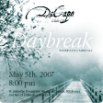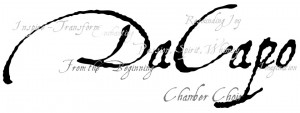
Da Capo’s concert on Saturday night at St. John the Evangelist Anglican Church was a joyous paean to innocence and awakening.
Daybreak: Sounds of a New Day brought us into the tender, crisp light of a morning in spring.
Featuring one of artistic director Leonard Enns’s works — a musical setting of several poems from William Blake’s Songs of Innocence — the first part of the program reflected this fresh simplicity.
It seemed altogether appropriate for Enns to have selected something from early in his own career for such a concert. The music evoked the pastoral tradition suggested by the Songs of Innocence, with their motifs of idealized, rural beauty.
The simplicity of the themes blended at times with an underlying awareness of the sacred — as in the Lamb — in which the harmonies were allowed to shine through with unadorned clarity.
Laughing Song carried with it the beautifully evocative suggestion that when Nature laughs the world becomes green and fresh and burgeons with the new life that is born of her cosmic mirth.
The Eastwood Collegiate Treble Choir made a guest appearance. Under the direction of one of Da Capo’s sopranos, Shannon Beynon, they sang with an energetic charm that worked well for their selection.
A number of Latin-American flavoured pieces were also featured in the early part of the program. Sung in Spanish, they incorporated Central and South American rhythms and motifs.
Though the harmonies were impeccably executed, the sound on these pieces was often more light and ethereal than earthy and sensual. The acoustics of the venue also meant that the sounds lingered, instead of snapping with the tight rhythms demanded by the Latin-American style.
But for all that, this reframing of the music was also interesting and enjoyable, creating a fusion that was predominantly choral with a touch of Latin for added zest.
Though the early program was lovely and enjoyable, it was after the intermission that the breathtaking skill and potency of the Da Capo ensemble was truly showcased.
Here, we encountered works by Sid Robinovitch and Eric Whitacre.
Robinovitch’s Sensemaya — a chant for killing a snake — succeeded especially well because it did not attempt to recreate the chant as it might originally have been performed. Instead, it took the words and the rhythms and created something altogether new out of them. Fresh and dynamic, the performance was lively and engaging.
The text of Octavio Paz’s poem Olvido deals with the process of falling into oblivion — that point in which the sense of the self is eradicated, be it in darkness, in sleep or in love. Robinovitch’s musical reading interacted beautifully with the text, playing off the oceanic imagery by evoking deep, still currents in the piano’s musical progressions. Upon that, the choral voices shifted like the ebb and flow of the waves — emissaries between the shore and the depths.
But the true jewels of the second half were the Whitacre pieces. They also featured text by Octavio Paz, whose work explodes with vibrant, fiercely visual imagery. When combined with Whitacre’s music, the idiom becomes so vivid, so potently evocative, that it crosses over into the magically real — a version of reality turned up to 11.
In Cloudburst, Whitacre uses the tonal palette to paint a sound-picture so convincing that it is as if we have been transported into the centre of a rising storm.Voice and text interact in unexpected ways for deeply experiential music.
We are there, as tension swells, the storm breaks in erupting thunder, and the rain begins to fall. It is a moment of pure epiphany. As the storm abates, we are left with the breaking of the light, the freshly-washed landscape, and the glistening vision of a new beginning.
Daybreak.




